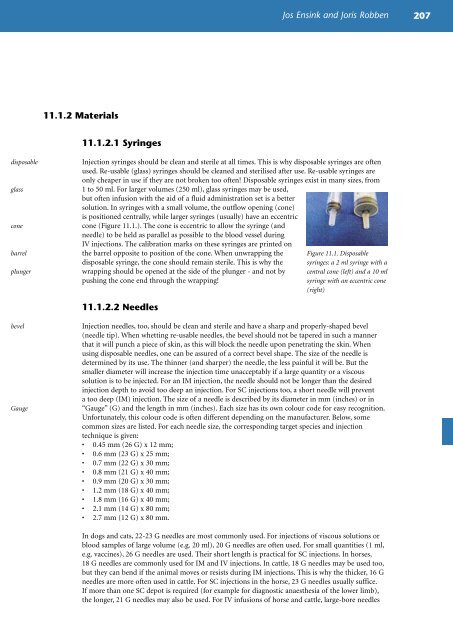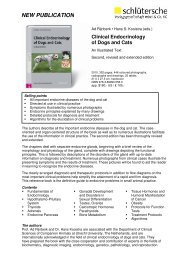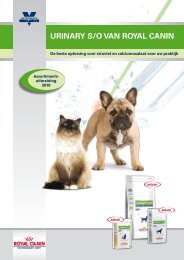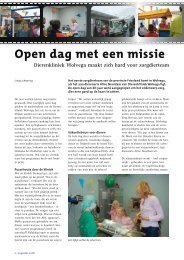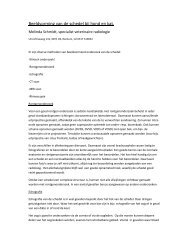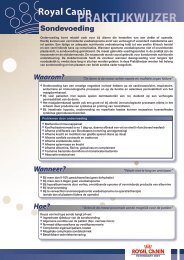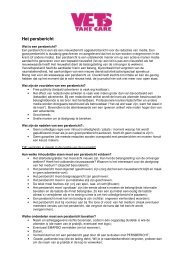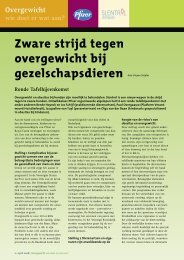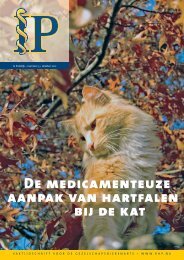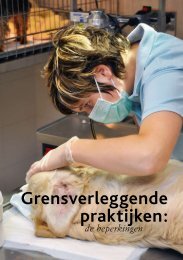Injection techniques for drug administration and methods of restraint
Injection techniques for drug administration and methods of restraint
Injection techniques for drug administration and methods of restraint
Create successful ePaper yourself
Turn your PDF publications into a flip-book with our unique Google optimized e-Paper software.
disposable<br />
glass<br />
cone<br />
barrel<br />
plunger<br />
bevel<br />
Gauge<br />
11.1.2 Materials<br />
11.1.2.1 Syringes<br />
<strong>Injection</strong> syringes should be clean <strong>and</strong> sterile at all times. This is why disposable syringes are <strong>of</strong>ten<br />
used. Re-usable (glass) syringes should be cleaned <strong>and</strong> sterilised after use. Re-usable syringes are<br />
only cheaper in use if they are not broken too <strong>of</strong>ten! Disposable syringes exist in many sizes, from<br />
1 to 50 ml. For larger volumes (250 ml), glass syringes may be used,<br />
but <strong>of</strong>ten infusion with the aid <strong>of</strong> a fluid <strong>administration</strong> set is a better<br />
solution. In syringes with a small volume, the outflow opening (cone)<br />
is positioned centrally, while larger syringes (usually) have an eccentric<br />
cone (Figure 11.1.). The cone is eccentric to allow the syringe (<strong>and</strong><br />
needle) to be held as parallel as possible to the blood vessel during<br />
IV injections. The calibration marks on these syringes are printed on<br />
the barrel opposite to position <strong>of</strong> the cone. When unwrapping the<br />
disposable syringe, the cone should remain sterile. This is why the<br />
wrapping should be opened at the side <strong>of</strong> the plunger - <strong>and</strong> not by<br />
pushing the cone end through the wrapping!<br />
11.1.2.2 Needles<br />
Jos Ensink <strong>and</strong> Joris Robben 207<br />
Figure 11.1. Disposable<br />
syringes: a 2 ml syringe with a<br />
central cone (left) <strong>and</strong> a 10 ml<br />
syringe with an eccentric cone<br />
(right)<br />
<strong>Injection</strong> needles, too, should be clean <strong>and</strong> sterile <strong>and</strong> have a sharp <strong>and</strong> properly-shaped bevel<br />
(needle tip). When whetting re-usable needles, the bevel should not be tapered in such a manner<br />
that it will punch a piece <strong>of</strong> skin, as this will block the needle upon penetrating the skin. When<br />
using disposable needles, one can be assured <strong>of</strong> a correct bevel shape. The size <strong>of</strong> the needle is<br />
determined by its use. The thinner (<strong>and</strong> sharper) the needle, the less painful it will be. But the<br />
smaller diameter will increase the injection time unacceptably if a large quantity or a viscous<br />
solution is to be injected. For an IM injection, the needle should not be longer than the desired<br />
injection depth to avoid too deep an injection. For SC injections too, a short needle will prevent<br />
a too deep (IM) injection. The size <strong>of</strong> a needle is described by its diameter in mm (inches) or in<br />
“Gauge” (G) <strong>and</strong> the length in mm (inches). Each size has its own colour code <strong>for</strong> easy recognition.<br />
Un<strong>for</strong>tunately, this colour code is <strong>of</strong>ten different depending on the manufacturer. Below, some<br />
common sizes are listed. For each needle size, the corresponding target species <strong>and</strong> injection<br />
technique is given:<br />
• 0.45 mm (26 G) x 12 mm;<br />
• 0.6 mm (23 G) x 25 mm;<br />
• 0.7 mm (22 G) x 30 mm;<br />
• 0.8 mm (21 G) x 40 mm;<br />
• 0.9 mm (20 G) x 30 mm;<br />
• 1.2 mm (18 G) x 40 mm;<br />
• 1.8 mm (16 G) x 40 mm;<br />
• 2.1 mm (14 G) x 80 mm;<br />
• 2.7 mm (12 G) x 80 mm.<br />
In dogs <strong>and</strong> cats, 22-23 G needles are most commonly used. For injections <strong>of</strong> viscous solutions or<br />
blood samples <strong>of</strong> large volume (e.g. 20 ml), 20 G needles are <strong>of</strong>ten used. For small quantities (1 ml,<br />
e.g. vaccines), 26 G needles are used. Their short length is practical <strong>for</strong> SC injections. In horses,<br />
18 G needles are commonly used <strong>for</strong> IM <strong>and</strong> IV injections. In cattle, 18 G needles may be used too,<br />
but they can bend if the animal moves or resists during IM injections. This is why the thicker, 16 G<br />
needles are more <strong>of</strong>ten used in cattle. For SC injections in the horse, 23 G needles usually suffice.<br />
If more than one SC depot is required (<strong>for</strong> example <strong>for</strong> diagnostic anaesthesia <strong>of</strong> the lower limb),<br />
the longer, 21 G needles may also be used. For IV infusions <strong>of</strong> horse <strong>and</strong> cattle, large-bore needles


